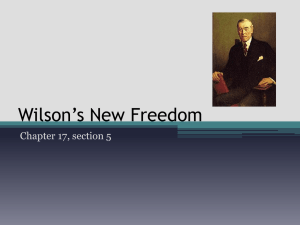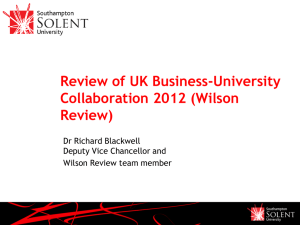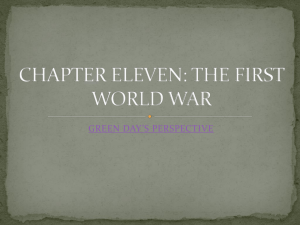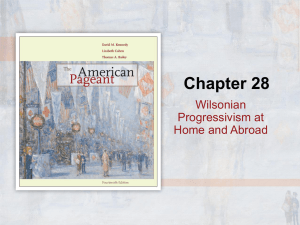Student Diversity and Predictors of Success in the
advertisement
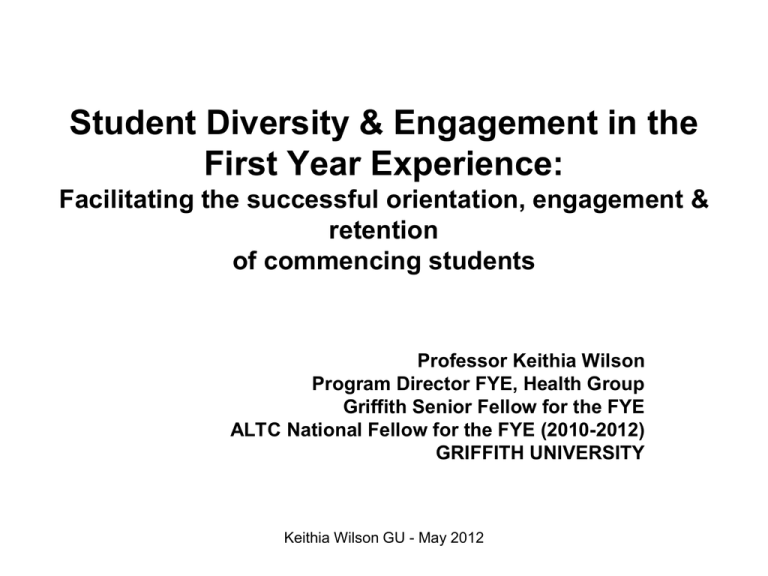
Student Diversity & Engagement in the First Year Experience: Facilitating the successful orientation, engagement & retention of commencing students Professor Keithia Wilson Program Director FYE, Health Group Griffith Senior Fellow for the FYE ALTC National Fellow for the FYE (2010-2012) GRIFFITH UNIVERSITY Keithia Wilson GU - May 2012 Acknowledgment to Country • In the Spirit of Reconciliation • Following on from Sorry Day • I would like to acknowledge & honour the Traditional Custodians of the land we are meeting on today, the Yugambeh People and pay respect to their Elders past & present Keithia Wilson GU - May 2012 Overview A Story in 2 parts – 1. Context for the First Year Experience 2. Predictors of early student engagement & academic success Keithia Wilson GU - May 2012 Part 1 Current Context for the FYE Keithia Wilson GU - May 2012 Federal Gov’t reform agenda in Higher Education Aims to Widen student participation in Higher Education – A FAIR GO! (Bradley Report, 2008) Increase the access of students from low SES & disadvantaged backgrounds to university (higher numbers - Target increase from 12% to 20% by 2020) Increase the success of students from low SES & disadvantaged backgrounds at university (higher student retention) Moving from an elite model of HE (0-15% participation) to a mass model of HE (16-50%) (Trow, 2004) Keithia Wilson GU - May 2012 Student Diversity Traditional Students (TS) Non-Traditional Students (NTS) • • • • • • • • • • • • • • • medium-high SES higher entry levels second generation full time on-campus elite model low SES lower entry levels first-in-family part-time & working not on-campus much home care responsibilities rural/remote Indigenous International Non-English speaking/Refugee mass model Keithia Wilson GU - May 2012 What are assumed knowledge & capabilities? Academic Skills • Information Literacy • Computer Literacy • Reading Skills • Written Communication • Numeracy Skills • Critical thinking & analysis • Independent Learning (self-regulation) viz. time on task, self-study, time management, uni-work-social life balance, successful student behaviour Keithia Wilson GU - May 2012 What are assumed knowledge & capabilities? Academic/Cultural/Social Capital – the “Hidden Curriculum” 1.Student role Understanding student role expectations & appropriate & effective behaviour (realistic role appraisal; predictors of academic success; work-family-study balance) 2.Performance Expectations Reading the academic context to accurately determine performance requirements re studying & assessment standards 3.Help-seeking Capacity for help-seeking without fear of negative labelling (dumb/stupid) 4.Identity as a student Sense of belonging & personal fit with university (overcome the “outsider within” phenomenon – “A stranger in a foreign land”) Keithia Wilson GU - May 2012 Griffith University context • Large metropolitan university in Brisbane (1 of 7 in S-E Qld, & 1 of 4 in Brisbane) • Multi-campus - 5 campuses x 60 k corridor • Student enrolment of 40,000 • 70% of students are first-in-family at uni - FIF correlates with low SES & lower entry scores • 6th highest low SES student intake in Australia • 3rd highest Indigenous student intake in Australia • 25% International student enrolment • 10% students studying in distance mode Keithia Wilson GU - May 2012 Evolution of Intervention Approaches to FYO&E • First Generation Strategies = Co-Curricular - A focus on designing FYO&E supplemental activities & strategies which are outside of the classroom • Second Generation Strategies = Curricular - A focus on enhancing FY curriculum design, pedagogy & assessment practices Keithia Wilson GU - May 2012 Evolution of Intervention Approaches to the FYE – the future! Third Generation Strategies = Whole-of-Institution - A focus on an Institution wide approach to 1st & 2nd generation strategies, with practice standardisation & QA mechanisms for continuous improvement Whole-of-School/Program - A focus on the strategic combination of 1st & 2nd generation strategies for a particular disciplinary context (School or Program) Keithia Wilson GU - May 2012 Part 2 Predictors of Early Student Engagement & Academic Success with diverse students Keithia Wilson GU - May 2012 Early Student Experience What factors make a difference to our commencing students’ experience and outcomes? What might we do to enhance student outcomes? Keithia Wilson GU - May 2012 What makes a difference to commencing students’ experience and outcomes? What were we interested in? What student and university factors predict: • Early student satisfaction • Students’ Semester 1 academic success (GPA) • Students’ Attrition/Retention into year 2 How did we approach this? • Starting@Griffith survey (weeks 6-8) and feedback process • 2006 cohort (n = 2,587) of commencing students tracked for 3 years (2006-2008) Keithia Wilson GU - May 2012 The ‘Five-Senses’ of Student Success (Lizzio, 2006) Sense of Connectedness Sense of Capability Sense of Academic Culture Sense of Resourcefulness Sense of Purpose Keithia Wilson GU - May 2012 What predicts commencing students’ satisfaction with their degree program? Sense of Purpose Strongly Enhances Sense of Capability Enhances Sense of Connection Enhances Good Teaching Enhances Perceived Effectiveness Enhances of Orientation Time on Task Enhances Keithia Wilson GU - May 2012 Commencing Student Satisfaction What predicts commencing students’ academic outcomes? Academic Capital Low SES First in Family ESL Reduces Competing Demands Time in employment Time as carer Reduces Task Engagement @ Uni Attendance at Orientation Intended time on study Strongly Enhances Prior Academic Achievement Enhances Entry Level Scores to HEd Keithia Wilson GU - May 2012 Semester 1 academic achievement What predicts commencing students’ retention? Academic Capital - Competing Demands - Task Engagement @ Uni + Semester 1 GPA Prior Academic Achievement + Sense of Purpose + + + Student Satisfaction + Keithia Wilson GU - May 2012 Student Retention So what are the take-away messages? • Entry score is influential but this is significantly outweighed by ‘time on task’. • Lower academic capital at entry does not make a difference to ‘student satisfaction’ but does negatively predict ‘early academic achievement’. (The window of risk and opportunity is early on) • Lower academic capital/’at risk’ social demographics do not predict academic achievement in later years. (Once students get off to a good start their present is more important than their past ) students who are “First-in-Family” are just as likely to succeed (pass & graduate) as second generation students. Keithia Wilson GU - May 2012 What is Student Diversity? Traditional Students (TS) Non-Traditional Students (NTS) medium-high SES second generation higher entry levels full time on-campus • • • • • • • • • • • low SES first-in-family lower entry levels full-time & working on-campus less Indigenous International NESB (including refugees) disability home care responsibilities from rural & remote settings Keithia Wilson GU - May 2012 The research evidence shows…. • Despite low access rates, the success rate (or tendency to pass their year’s subjects) of low SES students is 97% of the pass rates of their medium & high SES peers & has been stable over the last 5 years. (Bradley et al, 2008:30) • This success rate is premised on the provision of a range of support systems Keithia Wilson GU - May 2012 Low SES students need support to succeed • Once students from disadvantaged backgrounds have entered university, the likelihood of them completing their course of study is broadly similar to that of the general higher education population. Often, however, they require higher levels of support to succeed, including financial assistance & greater academic support, mentoring & counselling services. (Transforming Australia’s Higher Education System, Commonwealth of Australia, 2009:14) Keithia Wilson GU - May 2012 Some national data on the success of low SES students • LSAY data: “If students from a low SES background get to uni, their background does not negatively affect their chances of completing the course” (Marks, 2007). • Monash: “students from relatively disadvantaged schools who gain lower ENTERs in Year 12, subsequently catch up to, & then overtake their more privileged counterparts from other school types once at university” (Dobson & Skuja, 2002). • UniSA: “once students gain entry they have a high rate of retention & in most cases perform as well as or better than other school leavers” (Tranter et al., 2007). • Griffith: “students who are FIF are just as likely to succeed as 2nd generation students” (Lizzio, 2009). Keithia Wilson GU - May 2012 What do we know from research about predictors of success in first year? Students are more likely to succeed if they: • Invest time on task time spent studying each week is the strongest predictor • Regularly attend lectures & tutorials increased learning opportunities also a strong predictor • Develop a social network at uni knowing one person’s name is a protective factor against dropping out • Have a clear goal or purpose for attending uni (sense of vocational direction & purpose especially) a strong predictor of success • Engage with the online environment moderates success at university • Balance commitments (working on average not more than 15 hours a week in paid employment) making appropriate time for study predicts success • Have some sense of academic self-confidence predicts success (self-efficacy & an expectation of success is foundational to success in life) Keithia Wilson GU - May 2012 What do we know from research about risk factors in first year? Students are more likely to drop-out and/or fail if they: • Don’t study & invest time on task • Don’t regularly attend lectures & tutorials (with the exception of a small group of young, very intellectually bright males) • Don’t develop a (small) social network at university • Don’t have a sense of purpose (esp vocational purpose) in their degree • Don’t have access to or engage with the online environment • Do work more than 25 hours per week while studying full time • Don’t believe that they can be successful (hope) Keithia Wilson GU - May 2012 So what are the take-away messages? • Sense of purpose and academic achievement (GPA) are the key factors in predicting Year 1 student retention. Sense of purpose functions as a protective factor for student retention. • Effectiveness of and attendance at orientation is a ‘sleeper factor’ in both soft and hard student outcomes. Keithia Wilson GU - May 2012 Three priorities for action 1. Strategic and assertive orientation to facilitate ‘conditions for success’ (e.g., realistic appraisal, time on task etc) & early student engagement strategies to increase attendance 2. Systematic purpose-building interventions in co-curricular & curricular modes at the unit/ course & program levels 3. An integrated whole-of-school approach (curricular and co-curricular) to student transition as a meta-goal of the first-year@ university Keithia Wilson GU - May 2012 Whole-of-School approach • Beyond a culture of ‘delegated responsibility’ to roles • Collective leadership and shared vision for the FYE • Establishing a FY Leadership Team & an ongoing FY Enhancement Team (FY unit convenors + FY Leaders) to vision, plan & implement change in FY • Partnership across academic & service (professional) elements • Integration of strategic curricular and co-curricular strategies for a particular disciplinary context & student profile Keithia Wilson GU - May 2012 Finally…a note about important intangibles Life requires us to be 100 per cent committed to actions of which we are only 51 per cent certain. Albert Camus You must be the change you want to see….. Mahatma Gandhi Keithia Wilson GU - May 2012


